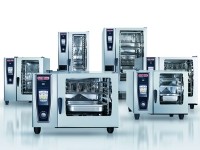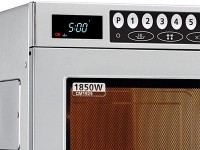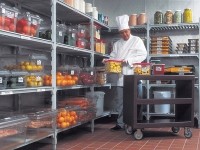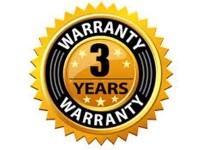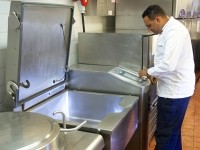Equipping your kitchen: a buyer's guide
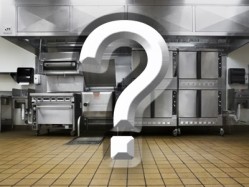
1) Design & layout
As yesterday’s kitchen equipment article concluded, the easiest way to achieve a dream kitchen is to start from scratch and build from the ground up. But most chefs don’t have the luxury of designing an entirely new kitchen and instead have to work with an existing space.
When buying new equipment, consider where and how it will fit into your kitchen alongside any existing products. Two smaller pieces of kit may be better than one larger unit, as they may offer more flexibility. Buying multiple frying units, for example, could avoid heating up too much oil during periods of slower trade.
Another point to consider here is in food allergens. As another of our Special Features showed, kitchens can be structured in a way to avoid cross-contamination, which will be all-the-more important when the new Food Information Regulations come into play later this year.
2) Space at a premium?
In smaller kitchens, multi-functional items can be a big help. Lee Norton, managing director of Rational UK – which recently launched a new range of combi ovens – says: “Increasingly a ‘combi’ is a ‘must have’ in commercial kitchens because it offers a variety of cooking processes on a small footprint.
“Combis aren't just for big kitchens. Great results, energy savings, retention of nutritional values, versatility and ease of use are as beneficial in smaller sites as in larger ones. So when you select your supplier, make sure they have the right size model for your operation.
“A key advantage that is especially valuable in smaller sites, with an advanced unit like the SelfCookingCenter whitefficiency, is its ability to cook lots of smaller portions of different foods at the same time, on different shelves, with no cross contamination of flavour or aroma.”
3) Optimise output
Whatever the piece of equipment, you must ensure that your chosen model will provide the output you’re looking for. As Heather Beattie, product brand manager for Nisbets, points out: “When equipping a kitchen, caterers should always work out whether each unit they have will be able to produce the food and the quantities they require, and if it has the capacity to grow with them.”
Good manufacturers should also be able to provide reliable output figures for their equipment, but you should check that the capabilities and output quoted are like-for-like.
4) Call of duty…
Make sure you buy the correct level of duty and power. Don’t buy into cheaper options or lighter duty kit than required as you’ll probably end up buying it twice. Stainless steel interiors and exteriors will last longer than aluminium, for example. Models that use recognised branded components rather than cheaper counterparts should also have a longer service life.
As Watts from Samsung Professional Appliances advises: “Select a model that’s powerful enough for your requirements. Standard commercial microwave ovens vary from around 1000 to 1850W -the more power, the faster it will be. The danger of buying a unit that’s not powerful enough for your throughput is that it will be overworked and break down.”
5) Focus on reliability
“Reliability is essential,” says Simon Aspin, commercial director of Hubbard Ice Systems. “Whatever brand you chose, make sure that it offers after-sales support, including holding a good stock of spare parts and consumables (such as water filters), and can arrange ‘preventative planned maintenance’ service contracts on equipment.
6) … And energy efficiency
This isn’t just another buzzword. “Wherever possible you should source energy-efficient products – an investment that will pay for itself in the long-term,” explains Graham Bean, national design director at Lockhart Catering Equipment. “And we all have an obligation to reduce our environmental impact on the planet.”
You should also carefully consider the energy source. Decide whether you need gas or electric and weigh up the costs and the advantages and disadvantages of each. The basic rule of thumb is that electric equipment is cheaper in terms of initial outlay, but can be more expensive to run.
With the inexorably rising cost of energy, water and detergents, energy consumption is also likely to be the biggest factor in choosing a warewasher in the next few years. So says Paul Crowley, marketing manager at Winterhalter UK.
“The best warewashers can last a long time - it's not unreasonable to expect one to last more than a decade - so the running costs are critical,” says Crowley. “Check how much this will be in energy, water and chemical consumption.”
7) Is it easy to clean?
Look for dirt traps – there shouldn’t be any on the best-designed equipment. There’s no point buying the latest piece of kitchen kit if it looks old and worn out after a month.
8) Don’t forget the menu
As Graham Kille, managing director of Frima, explains: “The equipment required each day will depend on the menu and the numbers being catered for. Purchasing multifunctional cooking equipment, for example, means the equipment can be used for a variety of processes and thus adapt to the menu.”
If you’re thinking about buying a bespoke cooking suite based on your offering, treble-check it meets your requirements. Once it’s made, there’s no going back and any misjudgements could be very costly.
9) Choose your suppliers wisely
No back-of-the-lorry stuff… Buy from a reputable supplier to be sure of compliance with all relevant European safety regulations.
Philip Howard, managing director of Catering Design Group, advises: “You must ensure you opt for a supplier with an adequate UK-based warranty and service back-up - including availability of spare parts. Any long-term equipment breakdown can severely impact your ability to deliver the full menu.”
10) … And your manufacturers
Always check for a manufacturers’ warranty to see if it includes parts and labour. Do they offer descent after-sales care, training or any other additional services that could prove useful to you?
David Watts, general manager of Samsung Professional Appliances, points out the advantages of buying a commercial model. “Don’t be tempted by domestic or cheap, un-branded Chinese products,” says Watts. “Make sure that the warranty is backed by the manufacturer. Samsung offer a three-year, on-site, full parts and labour warranty - if we can’t repair we’ll replace.”
Jeremy Hall, managing director of Precision Refrigeration, adds: “You should look for a reputable UK manufacturer who will have spare parts in stock locally. Don’t get caught waiting for components from the other side of the world or from a company that has gone out of business.”
11) Take ideas from your peers
Speak with chefs who already use the gizmo to get their opinion. If you’re buying a piece of equipment, you need to know about it. Go and see a chef who has it and ask them all about it or, even better, try and work with it yourself first.
As Jonas Karlsson of Linnea says: “Executive or head chefs will have their equipment wish-lists and while they may not always be within budget, they do need to be consulted as they’ll be the ones using the equipment every day.
12) Do you really need it?
This may sound like a basic question, but kitchens up and down the country are full of equipment that seemed like a good idea at the time but now collect dust.
Howard from Catering Design Group believes you should always carefully consider the benefit of refurbishment versus replacement. “Whilst refurbishment would appear to make complete sense on the surface - financially and sustainably - there may well be additional associated costs, such as amendments to ventilation to meet current guidelines,” he says.
Take a look back at last year’s Kitchen Equipment Special Feature to fully weigh up the pros and cons of a total refurbishment versus replacement of one or two key items.
13) Stick to the budget
Again this one sounds basic, but you must know your budget and stick to it. Think carefully before opting for the cheapest piece of equipment you can find – a low price tag may not be the bargain it seems.
Consider the whole life cost, which means taking into consideration purchase price, operational cost, maintenance and life expectancy - and setting all of that against performance and profit potential.
14) Try it out on staff
New kit needs to be suitable for everyone to use easily and properly. As Watts from Samsung points out: “Small additions such as touch-pad controls make it easy for staff to get it right, even if they have limited kitchen skills. A manual model may be better for the chef who wants total control of the process.”
Ashley Sheppard, commercial director for Call Systems Technology, makes the point that you should make any kitchen training materials bilingual. “Our TeamAssist system is ideal for those who do not speak English as a first language, as it can translate recipes and kitchen processes, with pictures and video to assist,” says Sheppard.
15) Be forward thinking...
Ask whether the equipment is future-proof and discover when a new model may be produced. You’ll kill yourself if you fork out on an expensive piece of kit only for a better model to come out two months later. Check if it can be upgraded with new software so that it doesn’t become obsolete quickly.
Mark Hogan of FEM, which distributes the Alto Shaam range of cooking equipment, says: “If you’re buying replacement equipment it’s tempting to go for like-for-like, just for convenience. But it’s always worth considering what else is available – the chances are what you are replacing is ten years old, and there have been plenty of technological innovations in the last decade.
“It may mean you will need to do more in terms of training, but the benefits could more than compensate.”
Tomorrow, look out for our interactive picture guide which rounds up the latest and hottest new products available.
You can read all our Equipping your kitchen articles here.
